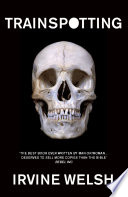Estimated read time: 5 min read
One Sentence Summary
A group of heroin addicts navigate the gritty streets of Edinburgh in this raw and darkly comic novel.
Table of Contents
Introduction
"Trainspotting" is a compelling novel written by Irvine Welsh. Published in 1993, this gritty and darkly humorous book explores the lives of a group of heroin addicts living in Edinburgh, Scotland. It delves into the themes of addiction, friendship, poverty, and the struggles of youth, presenting a raw and unflinching account of a subculture rarely examined in literature.
Brief Synopsis
Set in the 1980s, "Trainspotting" follows the lives of a group of friends who are deeply entrenched in the world of heroin addiction. The story primarily revolves around Mark Renton, Sick Boy, Spud, Begbie, and Tommy, each with their own unique backgrounds and motivations.
The narrative takes place in various locations in Edinburgh, including council estates, pubs, drug dens, and public toilets. These settings serve as a microcosm of the city, reflecting the social and economic issues that plague it.
Main Events
The novel is divided into a series of vignettes, each focusing on a different event or character. Through these interconnected stories, Welsh weaves a tapestry of addiction, despair, and occasional moments of hope.
Some of the main events in the book include:
- Mark Renton's struggle with addiction: Renton, who serves as the novel's protagonist, battles with his heroin addiction throughout. He makes numerous attempts to quit, but is constantly drawn back into the world of drugs.
- Sick Boy's schemes and ambition: Sick Boy, known for his charm and good looks, is always looking for the next big opportunity. He seeks to make money through various shady schemes, often involving drugs and deception.
- Spud's humorous antics: Spud, the most likable and comedic character of the group, provides levity amidst the dark themes. His struggles with addiction are marked by a series of comical mishaps, making him a relatable and sympathetic figure.
- Begbie's violent outbursts: Begbie, the group's volatile and unpredictable member, is notorious for his explosive temper. His rage-fueled acts of violence add an element of danger to the story, reflecting the destructive consequences of addiction.
- Tommy's descent into addiction: Initially portrayed as the most stable of the group, Tommy's life unravels as he falls into the clutches of heroin. His transformation serves as a cautionary tale, highlighting the destructive power of addiction.
Main Characters
| Character | Description |
|---|---|
| Mark Renton | The protagonist and narrator, Renton is a smart and charismatic heroin addict. |
| Sick Boy | A smooth-talking opportunist with a taste for drugs, sex, and scheming. |
| Spud | The lovable, bumbling member of the group, whose comedic antics provide relief. |
| Begbie | A violent and volatile character prone to outbursts and acts of aggression. |
| Tommy | Initially the most stable member, Tommy's descent into addiction is tragic. |
Themes and Insights
- Addiction and its consequences: The central theme of "Trainspotting" is addiction and its profound impact on the lives of the characters. The book explores the physical, emotional, and psychological repercussions of drug abuse, painting a bleak picture of the cycle of addiction.
- Friendship and loyalty: Despite their destructive lifestyles, the characters in "Trainspotting" form a strong bond of friendship. Their loyalty to each other is tested repeatedly, revealing the power of human connection in the face of adversity.
- Poverty and social inequality: The novel addresses the issue of poverty and the stark social inequality present in Edinburgh. The characters' lives are deeply impacted by their economic circumstances, with limited opportunities and a sense of hopelessness pervading their existence.
- Escapism and disillusionment: The characters in "Trainspotting" turn to drugs as a means of escape from their harsh realities. The novel examines the allure and ultimate emptiness of this form of escapism, revealing the deep disillusionment experienced by the characters.
- Youth and rebellion: Set against the backdrop of Thatcher's Britain, "Trainspotting" reflects the rebellious spirit of youth and the desire to break free from societal constraints. The characters embody the defiance and recklessness often associated with young adulthood.
Reader's Takeaway
"Trainspotting" offers readers a gritty and unfiltered depiction of addiction and its consequences. The novel's raw and unapologetic narrative style transports readers into the seedy underbelly of Edinburgh, providing a nuanced exploration of the complexities of addiction and the human condition.
Through its vividly drawn characters and dark humor, the book challenges societal norms and sheds light on the struggles faced by those caught in the cycle of addiction. It offers a poignant and thought-provoking examination of the human capacity for change, redemption, and the power of friendship.
Conclusion
Irvine Welsh's "Trainspotting" is a groundbreaking novel that delves into the harrowing realities of addiction and its impact on the lives of a group of friends. Through its vivid characters, gritty setting, and unflinching portrayal of drug abuse, the book offers readers a compelling and thought-provoking exploration of human resilience, friendship, and the pursuit of meaning in a world plagued by poverty and despair.
"Trainspotting" stands as a timeless piece of literature that continues to resonate with readers worldwide, challenging societal norms and shedding light on the often-hidden struggles faced by those grappling with addiction.
Trainspotting FAQ
What is the genre of the book 'Trainspotting'?
Who is the author of 'Trainspotting'?
What is the main storyline of 'Trainspotting'?
Is 'Trainspotting' a standalone book or part of a series?
What is the writing style of 'Trainspotting'?
Has 'Trainspotting' been adapted into a movie?
Is 'Trainspotting' suitable for all readers?
Are there any trigger warnings for 'Trainspotting'?
What are some other notable works by Irvine Welsh?
What is the overall reception of 'Trainspotting'?





